PROBLEMS
WORKING WITH THE FIGURES
(The first 14 questions require inspection of text figures.)
Question 1
In the left-
Question 2
In the right-
Question 3
In Table 2-1, state the recessive phenotype in each of the seven cases.
Question 4
Considering Figure 2-8, is the sequence “pairing → replication → segregation → segregation” a good shorthand description of meiosis?
Question 5
Point to all cases of bivalents, dyads, and tetrads in Figure 2-11.
Question 6
In Figure 2-11, assume (as in corn plants) that allele A encodes an allele that produces starch in pollen and allele a does not. Iodine solution stains starch black. How would you demonstrate Mendel’s first law directly with such a system?
Question 7
Considering Figure 2-13, if you had a homozygous double mutant m3/m3 m5/m5, would you expect it to be mutant in phenotype? (Note: This line would have two mutant sites in the same coding sequence.)
Question 8
In which of the stages of the Drosophila life cycle would you find the products of meiosis?
Question 9
If you assume Figure 2-15 also applies to mice and you irradiate male sperm with X rays (known to inactivate genes), what phenotype would you look for in progeny in order to find cases of individuals with an inactivated SRY gene?
Question 10
In Figure 2-17, how does the 3:1 ratio in the bottom-
Question 11
In Figure 2-19, assume that the pedigree is for mice, in which any chosen cross can be made. If you bred IV-
Question 12
Which part of the pedigree in Figure 2-23 in your opinion best demonstrates Mendel’s first law?
Question 13
Could the pedigree in Figure 2-31 be explained as an autosomal dominant disorder? Explain.
BASIC PROBLEMS
Question 14
Make up a sentence including the words chromosome, genes, and genome.
Question 15
Peas (Pisum sativum) are diploid and 2n = 14. In Neurospora, the haploid fungus, n = 7. If you were to isolate genomic DNA from both species and use electrophoresis to separate DNA molecules by size, how many distinct DNA bands would be visible in each species?
Question 16
The broad bean (Viciafaba) is diploid and 2n = 18. Each haploid chromosome set contains approximately 4 m of DNA. The average size of each chromosome during metaphase of mitosis is 13 μm. What is the average packing ratio of DNA at metaphase? (Packing ratio = length of chromosome/length of DNA molecule therein.) How is this packing achieved?
Question 17
If we call the amount of DNA per genome “x,” name a situation or situations in diploid organisms in which the amount of DNA per cell is
x
2x
4x
Question 18
Name the key function of mitosis.
Question 19
Name two key functions of meiosis.
Question 20
Design a different nuclear-
Question 21
In a possible future scenario, male fertility drops to zero, but, luckily, scientists develop a way for women to produce babies by virgin birth. Meiocytes are converted directly (without undergoing meiosis) into zygotes, which implant in the usual way. What would be the short-
Question 22
In what ways does the second division of meiosis differ from mitosis?
Question 23
Make up mnemonics for remembering the five stages of prophase I of meiosis and the four stages of mitosis.
Question 24
In an attempt to simplify meiosis for the benefit of students, mad scientists develop a way of preventing premeiotic S phase and making do with having just one division, including pairing, crossing over, and segregation. Would this system work, and would the products of such a system differ from those of the present system?
Question 25
Theodor Boveri said, “The nucleus doesn’t divide; it is divided.” What was he getting at?
Question 26
Francis Galton, a geneticist of the pre-
Question 27
If children obtain half their genes from one parent and half from the other parent, why aren’t siblings identical?
Question 28
State where cells divide mitotically and where they divide meiotically in a fern, a moss, a flowering plant, a pine tree, a mushroom, a frog, a butterfly, and a snail.
Question 29
Human cells normally have 46 chromosomes. For each of the following stages, state the number of nuclear DNA molecules present in a human cell:
Metaphase of mitosis
Metaphase I of meiosis
Telophase of mitosis
Telophase I of meiosis
Telophase II of meiosis
Question 30
Four of the following events are part of both meiosis and mitosis, but only one is meiotic. Which one? (1) Chromatid formation, (2) spindle formation, (3) chromosome condensation, (4) chromosome movement to poles, (5) synapsis.
Question 31
In corn, the allele f′ causes floury endosperm and the allele f″ causes flinty endosperm. In the cross f ′/f′ ♀ × f″/f″ ♂, all the progeny endosperms are floury, but, in the reciprocal cross, all the progeny endosperms are flinty. What is a possible explanation? (Check the legend for Figure 2-7.)
Question 32
What is Mendel’s first law?
Question 33
If you had a fruit fly (Drosophila melanogaster) that was of phenotype A, what cross would you make to determine if the fly’s genotype was A/A or A/a?
Question 34
In examining a large sample of yeast colonies on a petri dish, a geneticist finds an abnormal-
What can be deduced from these results regarding the inheritance of the small-
colony phenotype? (Invent genetic symbols.) What would an ascus from this cross look like?
Question 35
Two black guinea pigs were mated and over several years produced 29 black and 9 white offspring. Explain these results, giving the genotypes of parents and progeny.
Question 36
In a fungus with four ascospores, a mutant allele lys-5 causes the ascospores bearing that allele to be white, whereas the wild-
lys-5 × lys-5+
lys-5 × lys-5
lys-5+ × lys-5+
Question 37
For a certain gene in a diploid organism, eight units of protein product are needed for normal function. Each wild-
If a mutation creates a null allele, do you think this allele will be recessive or dominant?
What assumptions need to be made to answer part a?
Question 38
A Neurospora colony at the edge of a plate seemed to be sparse (low density) in comparison with the other colonies on the plate. This colony was thought to be a possible mutant, and so it was removed and crossed with a wild type of the opposite mating type. From this cross, 100 ascospore progeny were obtained. None of the colonies from these ascospores was sparse, all appearing to be normal. What is the simplest explanation of this result? How would you test your explanation? (Note: Neurospora is haploid.)
Question 39
From a large-
Question 40
In the plant Arabidopsis thaliana, a geneticist is interested in the development of trichomes (small projections). A large screen turns up two mutant plants (A and B) that have no trichomes, and these mutants seem to be potentially useful in studying trichome development. (If they were determined by single-
F2 from mutant A: 602 normal; 198 no trichomes
F2 from mutant B: 267 normal; 93 no trichomes
What do these results show? Include proposed genotypes of all plants in your answer.
Under your explanation to part a, is it possible to confidently predict the F1 from crossing the original mutant A with the original mutant B?
Question 41
You have three dice: one red (R), one green (G), and one blue (B). When all three dice are rolled at the same time, calculate the probability of the following outcomes:
6 (R), 6 (G), 6 (B)
6 (R), 5 (G), 6 (B)
6 (R), 5 (G), 4 (B)
No sixes at all
A different number on all dice
Question 42
In the pedigree below, the black symbols represent individuals with a very rare blood disease.

If you had no other information to go on, would you think it more likely that the disease was dominant or recessive? Give your reasons.
Question 43
The ability to taste the chemical phenylthiocarbamide is an autosomal dominant phenotype, and the inability to taste it is recessive. If a taster woman with a nontaster father marries a taster man who in a previous marriage had a nontaster daughter, what is the probability that their first child will be
A nontaster girl
A taster girl
A taster boy
What is the probability that their first two children will be tasters of either sex?
 Unpacking the Problem 44
Unpacking the Problem 44
John and Martha are contemplating having children, but John’s brother has galactosemia (an autosomal recessive disease) and Martha’s great-
Can the problem be restated as a pedigree? If so, write one.
Can parts of the problem be restated by using Punnett squares?
Can parts of the problem be restated by using branch diagrams?
In the pedigree, identify a mating that illustrates Mendel’s first law.
Define all the scientific terms in the problem, and look up any other terms about which you are uncertain.
What assumptions need to be made in answering this problem?
Which unmentioned family members must be considered? Why?
What statistical rules might be relevant, and in what situations can they be applied? Do such situations exist in this problem?
What are two generalities about autosomal recessive diseases in human populations?
What is the relevance of the rareness of the phenotype under study in pedigree analysis generally, and what can be inferred in this problem?
In this family, whose genotypes are certain and whose are uncertain?
In what way is John’s side of the pedigree different from Martha’s side? How does this difference affect your calculations?
Is there any irrelevant information in the problem as stated?
In what way is solving this kind of problem similar to solving problems that you have already successfully solved? In what way is it different?
Can you make up a short story based on the human dilemma in this problem?
Now try to solve the problem. If you are unable to do so, try to identify the obstacle and write a sentence or two describing your difficulty. Then go back to the expansion questions and see if any of them relate to your difficulty.
Question 45
Holstein cattle are normally black and white. A superb black-
Question 46
Suppose that a husband and wife are both heterozygous for a recessive allele for albinism. If they have dizygotic (two-
Question 47
The plant blue-

Formulate a concise genetic hypothesis to explain these results. Explain all symbols and show all genotypic classes (and the genotype of the original plant).
How would you test your hypothesis? Be specific.
Question 48
Can it ever be proved that an animal is not a carrier of a recessive allele (that is, not a heterozygote for a given gene)? Explain.
Question 49
In nature, the plant Plectritis congesta is dimorphic for fruit shape; that is, individual plants bear either wingless or winged fruits, as shown in the illustration.
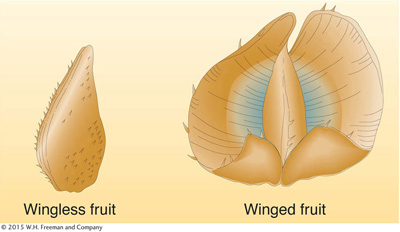
Plants were collected from nature before flowering and were crossed or selfed with the following results:
|
Number of progeny |
||
|---|---|---|
|
Pollination |
Winged |
Wingless |
|
Winged (selfed) |
91 |
1* |
|
Winged (selfed) |
90 |
30 |
|
Wingless (selfed) |
4* |
80 |
|
Winged × wingless |
161 |
0 |
|
Winged × wingless |
29 |
31 |
|
Winged × wingless |
46 |
0 |
|
Winged × winged |
44 |
0 |
*Phenotype probably has a nongenetic explanation.
Interpret these results, and derive the mode of inheritance of these fruit-
Question 50
The accompanying pedigree is for a rare, but relatively mild, hereditary disorder of the skin.
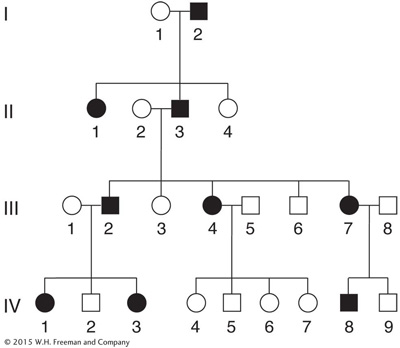
How is the disorder inherited? State reasons for your answer.
Give genotypes for as many individuals in the pedigree as possible. (Invent your own defined allele symbols.)
Consider the four unaffected children of parents III-
4 and III- 5. In all four- child progenies from parents of these genotypes, what proportion is expected to contain all unaffected children?
Question 51
Four human pedigrees are shown in the accompanying illustration. The black symbols represent an abnormal phenotype inherited in a simple Mendelian manner.
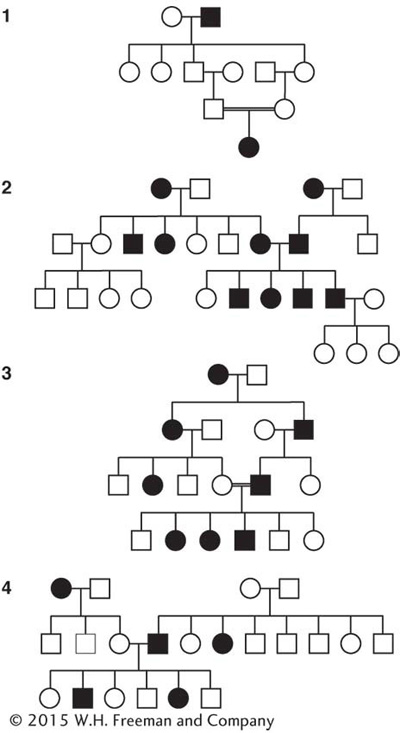
For each pedigree, state whether the abnormal condition is dominant or recessive. Try to state the logic behind your answer.
For each pedigree, describe the genotypes of as many persons as possible.
Question 52
Tay-
Draw the relevant parts of the pedigree, and show all the genotypes as completely as possible.
What is the probability that the cousins’ first child will have Tay-
Sachs disease, assuming that all people who marry into the family are homozygous normal?
Question 53
The pedigree below was obtained for a rare kidney disease.
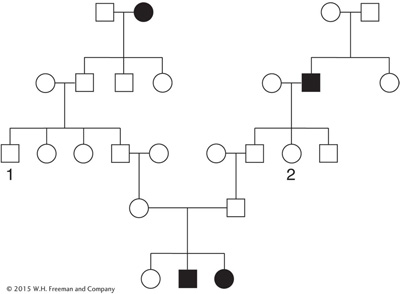
Deduce the inheritance of this condition, stating your reasons.
If persons 1 and 2 marry, what is the probability that their first child will have the kidney disease?
Question 54
This pedigree is for Huntington disease, a late-
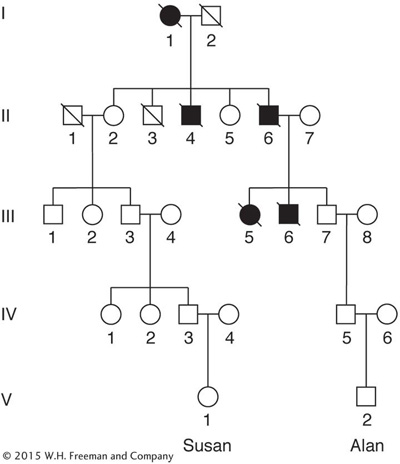
Is this pedigree compatible with the mode of inheritance for Huntington disease mentioned in the chapter?
Consider two newborn children in the two arms of the pedigree, Susan in the left arm and Alan in the right arm. Study the graph in Figure 2-24 and form an opinion on the likelihood that they will develop Huntington disease. Assume for the sake of the discussion that parents have children at age 25.
Question 55
Consider the accompanying pedigree of a rare autosomal recessive disease, PKU.
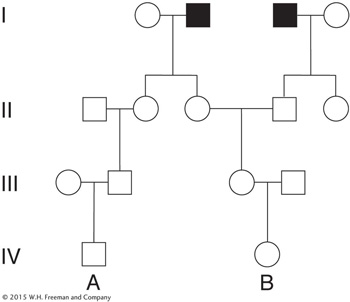
List the genotypes of as many of the family members as possible.
If persons A and B marry, what is the probability that their first child will have PKU?
If their first child is normal, what is the probability that their second child will have PKU?
If their first child has the disease, what is the probability that their second child will be unaffected?
(Assume that all people marrying into the pedigree lack the abnormal allele.)
Question 56
A man has attached earlobes, whereas his wife has free earlobes. Their first child, a boy, has attached earlobes.
If the phenotypic difference is assumed to be due to two alleles of a single gene, is it possible that the gene is X linked?
Is it possible to decide if attached earlobes are dominant or recessive?
Question 57
A rare recessive allele inherited in a Mendelian manner causes the disease cystic fibrosis. A phenotypically normal man whose father had cystic fibrosis marries a phenotypically normal woman from outside the family, and the couple consider having a child.
Draw the pedigree as far as described.
If the frequency in the population of heterozygotes for cystic fibrosis is 1 in 50, what is the chance that the couple’s first child will have cystic fibrosis?
If the first child does have cystic fibrosis, what is the probability that the second child will be normal?
Question 58
The allele c causes albinism in mice (C causes mice to be black). The cross C/c × c/c produces 10 progeny. What is the probability of all of them being black?
Question 59
The recessive allele s causes Drosophila to have small wings, and the s+ allele causes normal wings. This gene is known to be X linked. If a small-
Question 60
An X-
Question 61
Duchenne muscular dystrophy is sex linked and usually affects only males. Victims of the disease become progressively weaker, starting early in life.
What is the probability that a woman whose brother has Duchenne’s disease will have an affected child?
If your mother’s brother (your uncle) had Duchenne’s disease, what is the probability that you have received the allele?
If your father’s brother had the disease, what is the probability that you have received the allele?
Question 62
A recently married man and woman discover that each had an uncle with alkaptonuria (black urine disease), a rare disease caused by an autosomal recessive allele of a single gene. They are about to have their first baby. What is the probability that their child will have alkaptonuria?
Question 63
The accompanying pedigree concerns a rare inherited dental abnormality, amelogenesis imperfecta.

What mode of inheritance best accounts for the transmission of this trait?
Write the genotypes of all family members according to your hypothesis.
Question 64
A couple who are about to get married learn from studying their family histories that, in both their families, their unaffected grandparents had siblings with cystic fibrosis (a rare autosomal recessive disease).
If the couple marries and has a child, what is the probability that the child will have cystic fibrosis?
If they have four children, what is the chance that the children will have the precise Mendelian ratio of 3:1 for normal : cystic fibrosis?
If their first child has cystic fibrosis, what is the probability that their next three children will be normal?
Question 65
A sex-
What genotypes are possible for the mother of the color-
blind man? What are the chances that the first child from this marriage will be a color-
blind boy? Of the girls produced by these parents, what proportion can be expected to be color blind?
Of all the children (sex unspecified) of these parents, what proportion can be expected to have normal color vision?
Question 66
Male house cats are either black or orange; females are black, orange, or calico.
If these coat-
color phenotypes are governed by a sex- linked gene, how can these observations be explained? Using appropriate symbols, determine the phenotypes expected in the progeny of a cross between an orange female and a black male.
Half the females produced by a certain kind of mating are calico, and half are black; half the males are orange, and half are black. What colors are the parental males and females in this kind of mating?
Another kind of mating produces progeny in the following proportions: one-
fourth orange males, one- fourth orange females, one- fourth black males, and one- fourth calico females. What colors are the parental males and females in this kind of mating?
Question 67
The pedigree below concerns a certain rare disease that is incapacitating but not fatal.
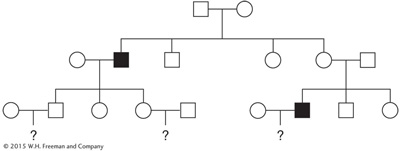
Determine the most likely mode of inheritance of this disease.
Write the genotype of each family member according to your proposed mode of inheritance.
If you were this family’s doctor, how would you advise the three couples in the third generation about the likelihood of having an affected child?
Question 68
In corn, the allele s causes sugary endosperm, whereas S causes starchy. What endosperm genotypes result from each of the following crosses?
s/s female × S/S male
S/S female × s/s male
S/s female × S/s male
Question 69
A plant geneticist has two pure lines, one with purple petals and one with blue. She hypothesizes that the phenotypic difference is due to two alleles of one gene. To test this idea, she aims to look for a 3:1 ratio in the F2. She crosses the lines and finds that all the F1 progeny are purple. The F1 plants are selfed, and 400 F2 plants are obtained. Of these F2 plants, 320 are purple and 80 are blue. Do these results fit her hypothesis well? If not, suggest why.

 Unpacking the Problem 70
Unpacking the Problem 70
A man’s grandfather has galactosemia, a rare autosomal recessive disease caused by the inability to process galactose, leading to muscle, nerve, and kidney malfunction. The man married a woman whose sister had galactosemia. The woman is now pregnant with their first child.
Draw the pedigree as described.
What is the probability that this child will have galactosemia?
If the first child does have galactosemia, what is the probability that a second child will have it?
CHALLENGING PROBLEMS
Question 71
A geneticist working on peas has a single plant monohybrid Y/y (yellow) plant and, from a self of this plant, wants to produce a plant of genotype y/y to use as a tester. How many progeny plants need to be grown to be 95 percent sure of obtaining at least one in the sample?
Question 72
A curious polymorphism in human populations has to do with the ability to curl up the sides of the tongue to make a trough (“tongue rolling”). Some people can do this trick, and others simply cannot. Hence, it is an example of a dimorphism. Its significance is a complete mystery. In one family, a boy was unable to roll his tongue but, to his great chagrin, his sister could. Furthermore, both his parents were rollers, and so were both grandfathers, one paternal uncle, and one paternal aunt. One paternal aunt, one paternal uncle, and one maternal uncle could not roll their tongues.
Draw the pedigree for this family, defining your symbols clearly, and deduce the genotypes of as many individual members as possible.
The pedigree that you drew is typical of the inheritance of tongue rolling and led geneticists to come up with the inheritance mechanism that no doubt you came up with. However, in a study of 33 pairs of identical twins, both members of 18 pairs could roll, neither member of 8 pairs could roll, and one of the twins in 7 pairs could roll but the other could not. Because identical twins are derived from the splitting of one fertilized egg into two embryos, the members of a pair must be genetically identical. How can the existence of the seven discordant pairs be reconciled with your genetic explanation of the pedigree?
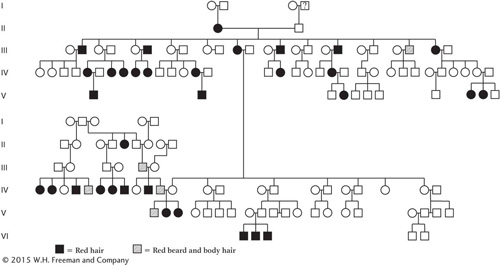
Question 73
Red hair runs in families, as the pedigree above shows.
(Pedigree data from W. R. Singleton and B. Ellis, Journal of Heredity 55, 1964, 261.)
Does the inheritance pattern in this pedigree suggest that red hair could be caused by a dominant or a recessive allele of a gene that is inherited in a simple Mendelian manner?
Do you think that the red-
hair allele is common or rare in the population as a whole?
Question 74
When many families were tested for the ability to taste the chemical phenylthiocarbamide, the matings were grouped into three types and the progeny were totaled, with the results shown below:
|
Children |
|||
|---|---|---|---|
|
Parents |
Number of families |
Tasters |
Nontasters |
|
Taster × taster |
425 |
929 |
130 |
|
Taster × nontaster |
289 |
483 |
278 |
|
Nontaster × nontaster |
86 |
5 |
218 |
With the assumption that PTC tasting is dominant (P) and nontasting is recessive (p), how can the progeny ratios in each of the three types of mating be accounted for?
Question 75
A condition known as icthyosis hystrix gravior appeared in a boy in the early eighteenth century. His skin became very thick and formed loose spines that were sloughed off at intervals. When he grew up, this “porcupine man” married and had six sons, all of whom had this condition, and several daughters, all of whom were normal. For four generations, this condition was passed from father to son. From this evidence, what can you postulate about the location of the gene?
Question 76
The wild-
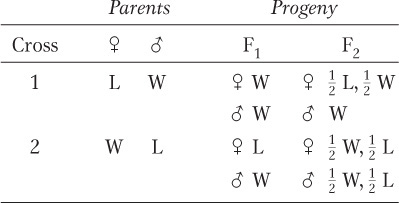
Provide a clear genetic explanation of the results in these two crosses, showing the genotypes of all individual moths.
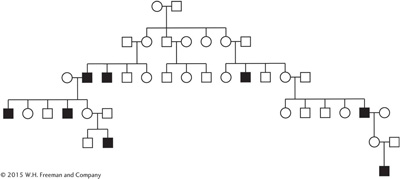
Question 77
The pedigree above shows the inheritance of a rare human disease. Is the pattern best explained as being caused by an X-
Question 78
A certain type of deafness in humans is inherited as an X-
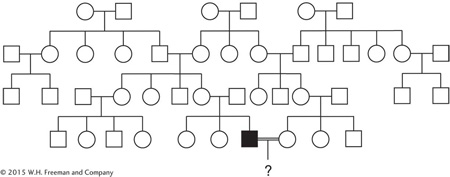
How would you advise the parents about the probability of their child being a deaf boy, a deaf girl, a normal boy, or a normal girl? Be sure to state any assumptions that you make.
Question 79
The accompanying pedigree shows a very unusual inheritance pattern that actually did exist. All progeny are shown, but the fathers in each mating have been omitted to draw attention to the remarkable pattern.
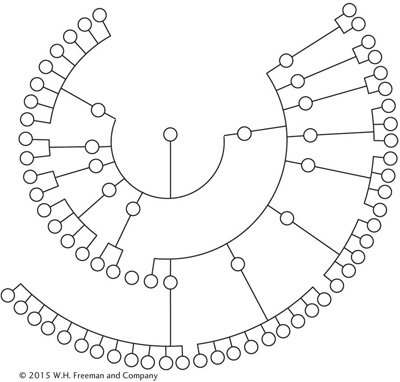
Concisely state exactly what is unusual about this pedigree.
Can the pattern be explained by Mendelian inheritance?